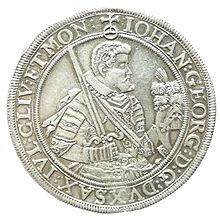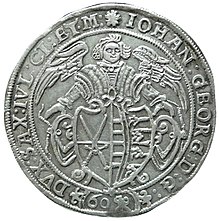Mint Neustadt an der Orla
The Mint of Neustadt an der Orla existed from 1621 to 1622 in Neustadt an der Orla . It was a state mint of the electoral duchy of Saxony under the reign of Johann Georg I. Before that there was said to have been a mint at the end of the 13th century . Further details are not known.
At the end of the 16th century, the value of the Reichstaler, pronounced according to the Reichsmünzfuß , began to rise slowly and then more rapidly than its legal value of 24 groschen, because the groschen that had to be paid for a taler had an ever lower silver content. The following development emerged from the records in Weimar:
This also increased the price of silver, calculated in guilders , and made small coins such as pennies, three groschen and kreuzers a loss. The mint masters began to lower the silver content of the small coins. More and more Reichstaler and other large coins were melted down and smaller and smaller coins were minted from them. Money and broken silver were traded everywhere and quick profits were made from them.
The electoral sovereign Johann Georg I also took part in this business, allegedly acting against his will. His advisor, Chamber Councilor Carl Christoph von Brandenstein, initiated the establishment of nine additional state mints from October 1621, which were supposed to mint new inferior state coins. One of these tipper mints was the mint in Neustadt an der Orla, established in 1621 and operated until 1622.
Mint masters were 1621–1622 Hans Treuttner and 1622 Christoph Kraft.
The mint masters minted Engeltaler land coins with an imprinted number of values of 30, 40 and 60 groschen as well as 8 groschen and 1 groschen, as well as a thaler cliff of 60 groschen and a groschen cliff.
The population was not informed about the issue of the new state coins. She was used to the use of various domestic and foreign coins.
The mint of Neustadt adOrla achieved the following profit by minting the tipper coins:
- Income 341,240 guilders
- Expenditure 267,558 guilders
- Surplus 73,682 guilders (27% return)
For comparison: a school teacher at that time had an annual income of 200 guilders, a servant 10 guilders. The losers were the citizens, who still believed in the value of the small coins. The cost of living rose faster than wages. The need gripped more and more citizens. The sovereigns themselves were also affected when taxes and duties were paid with inferior money. The citizens no longer wanted the inferior money. There were refusals to work and riots. This period from 1621 to 1623 is known as the tipper and luffing period .
After the mint dictated by Elector Johann Georg I on July 31, 1623, the kipper mints were closed and a return to orderly conditions was ordered. There was no official suspension of the kipper coins. They were left to their fate. The population devalued the coins on their own initiative .
Triple angel thaler from 1621
The minting of the new coins should be clearly different from that of the Reichstaler. The Reichstaler was still subject to the legal Reichsmünzfuß according to the Augsburg Imperial Law on May 30, 1566. The Elector Johann Georg I and his mint masters would not have dared to violate it. For this reason the imperial orb was replaced by a rosette as an expression of the coinage according to the imperial coinage order .
That is why the elector had the stamp of the old, struck from 1498 to 1571, known at home and abroad for their reliability, Schreckenberger . To make the thaler pretend perfect, the Engeltaler with 42.05 to 43.26 mm had about the same diameter as the Reichstaler with 42.48 to 43.07 mm. The material savings were made in the thickness: 1.88 mm instead of 2.35 mm.
A number was imprinted that had nothing to do with the intrinsic value of the coin. After the water sample of the illustrated triple angel thaler with a weight of 22.86 g, the fineness of the silver was 262 ‰. So 39 pieces were minted from the fine marrow silver. That's 5.993 g of silver per coin. A Reichstaler holds 25.984 g of silver.
On the back, the coat of arms with the Electoral Saxon possessions was not used, but a claim coat of arms . Two angels hold the coat of arms of the duchies of Jülich, Kleve and Berg. The reverse shows the mintmark N, which was used by the Neustadt adOrla mint in 1621 in a cartouche at the top edge.
Only the inscription with the name and title of the sovereign has not changed compared to the Reichstaler: IOHAN: GEORG: D: G: DVX: SAX: IVL: CL: ET◦MON: / SA: ROMANI: IMPERI◦ARCHIMARS◦ET◦EL ◦ECTOR: (IOHANNES GEORGIUS DEI GRATIA DUX SAXONIAE IVLIACI CLIVIAE ET MONTIUM / SACRI ROMANI IMPERII ARCHIMARSCHALLUS ET ELECTOR = Johann Georg by the grace of God, Duke of Saxony, Jülich, Kleve and Berg, Archmarshal and Elector of the Holy Roman Empire)
8 groschen piece 1622
This coin was minted by the mint master Hans Treuttner with a weight of 4.43 g, a diameter of 27.49–28.63 mm and a thickness of 1.06 mm. Only about eight surviving specimens are known.
The exact silver content is not known. With the edict of the Elector of March 26, 1622, he reduced the external value to 4 groschen. The coin circulated among the population at a realistic value of only 1 groschen.
The mint of the coin is based on the former Schreckenberger . In contrast to the pieces minted in Dresden, however, no angels are depicted as shield holders on the Neustädter Münze.
- Front:
Within an ornamental circle under the electoral hat, a heart-shaped, richly decorated coat of arms with the divided coat of arms of the Electorate of Saxony; Mintmaster's initials from HT ligated in a cartouche at the upper edge and the number of values in brackets formed from two crowns at the lower edge: 8g between the name of the mint owner and incomplete title as transcription to the right in Latin capital letters: IOHAN: GEORG / DE: GR: D: SAX ◦I: C
- Back:
Within an ornamental circle three richly decorated cartouches with the claim coats of arms for the duchies of Kleve, Berg and Jülich; separate year on both sides of the upper cartridge; at the top between three points mintmark N for the Neustadt a mint. d. O., then continuation of the ruler title as a legend to the right: SA: ROMANI: IMP: ARCHIMARS: ETEL
- Title written out:
IOHANNES GEORGIUS DEI GRATIA DUX SAXONIAE IVLIACI CLIVIAE / SACRI ROMANI IMPERII ARCHIMARSCHALLUS ET ELECTOR (Johann Georg by the grace of God Duke of Saxony, Jülich, Kleve / of the Holy Roman Empire Archmarshal and Elector)
- Edge:
Knurling on both sides / smooth edge / reverse embossing
Individual evidence
- ↑ Haupt, Walther: Sächsische Münzkunde , 1st edition 1974, p. 132.
- ↑ Haupt, Walther: Sächsische Münzkunde , 1st edition 1974, p. 235.
- ↑ Haupt, Walther: Sächsische Münzkunde , 1st edition 1974, p. 137.
- ^ Rittmann, Herbert: Deutsche Geldgeschichte 1484-1914 , Battenberg 1975, p. 233 ff.
- ^ Stößel, Johann Christoph: Attempt at a Chur-Saxon Coin History, Chemnitz 1780, pp. 499f., 520
- ↑ Stößel, Johann Christoph: Attempt at a Chur-Saxon coin history , Chemnitz 1780, p. 470f.
- ↑ Krug / Rahmenführer p. 90 and No. 412 quoted by the coin dealership Johannes Diller: Lagerliste 15 , 2016, p. 28 No. 731
- ^ Stößel, Johann Christoph: Attempt at a Chur-Sächsische Münzgeschichte , Chemnitz 1780, pp. 478, 499f., 506, 517f., 520f.






